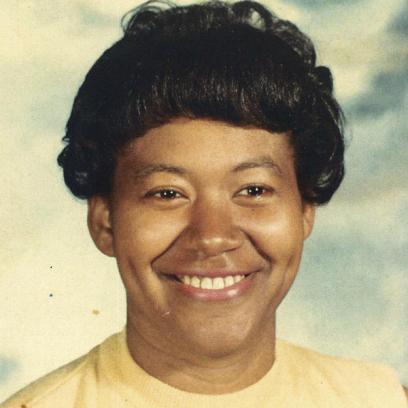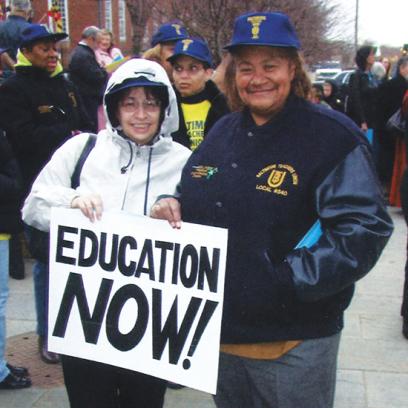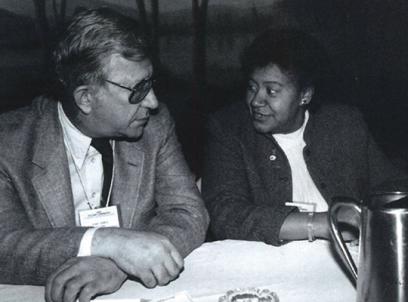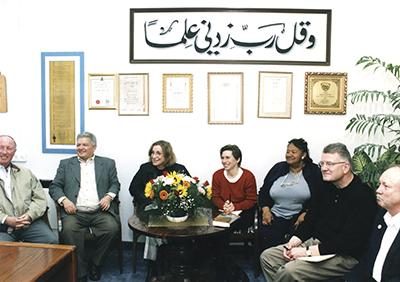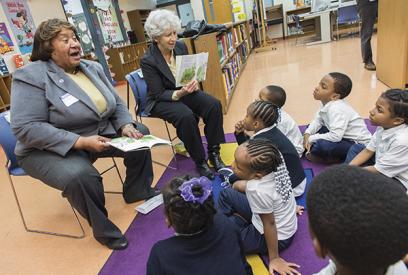Almost 50 years have passed since the day that first sparked my union activism, but I remember it clearly. It was 1966, and I was a teacher’s assistant—a paraprofessional—at Grove Park Elementary School in Baltimore, Maryland.
Previously, I had been a volunteer in the school’s library. Because my own children were attending the school, I wanted to help out. I enjoyed the work, so the principal recommended that I become a paraprofessional. The job seemed like a good fit, and I decided to pursue it since it would allow me to be home in time to pick up my children from school.
I was assigned to Liberty Elementary School, which enrolled many low-income students. I started out splitting my time between kindergarten and first-grade classrooms.
The paraprofessionals in our school worked well with teachers and the principal, so I didn’t really see a need for a union at first.
That changed thanks to something as mundane as the weather. Right after I started at Liberty, there was a blizzard. School district officials notified our school around 11 a.m. that schools were closing. Since the paraprofessionals were already supervising the students at that point because it was lunchtime, our school’s administrators sent the teachers home, and we paraprofessionals were left to dismiss the kids.
Because of the weather, parents were late picking up their children, and we ended up staying at school throughout the afternoon. The last student didn’t leave until 4 p.m., which meant that my colleagues and I didn’t leave until after that—and then we had to fight the blizzard to get home. Some people had to take a bus; I was driving, which was miserable, and I had two or three colleagues with me who needed to be dropped off. I made it home close to 8 p.m.
Our principal promised we would be paid for the extra time. He did try to make that happen, but the truth is we were never paid. School district officials justified their decision by saying that since schools were officially closed at 11 a.m. that day, we couldn’t get paid for work beyond that time.
For me, that was a slap in the face to working people who were doing their job to keep children safe and in school. The district’s position made me so angry that I turned to the union. When I tell that story now, I like to say that school officials in Baltimore didn’t know what they set loose at the time, but I think they learned over the next 50 years.
Affiliating with the Baltimore Teachers Union
After the blizzard, my colleagues and I started talking with representatives from the Baltimore Teachers Union (BTU), an AFT affiliate. The union’s representatives made it clear they wanted us paraprofessionals to join and to have full voting rights, whereas we didn’t feel as welcome with the National Education Association (NEA) affiliate, which only seemed to want paraprofessional members with high school diplomas.
In 1965, the Elementary and Secondary Education Act (the federal education law) created a new category of paraprofessionals called children’s aides. Aides were not required to have a high school diploma and didn’t have to take a test to become a paraprofessional. The NEA saw itself as a professional organization and didn’t want the federally funded children’s aides without diplomas to be part of its membership.
Well, my colleagues and I didn’t want to be separated like that. We wanted everyone—paraprofessionals (including children’s aides) and all school-related personnel (including parent liaison workers, bus drivers, school secretaries, and custodial staff members)—to be together in one unit. We also, of course, wanted the right to vote for officers. So we signed cards and joined the BTU. I began to serve as the spokesperson for the paraprofessionals and school-related personnel (PSRPs) at Liberty. I was already our advocate, but my role became more official when we all joined the union.
One of the first things I did after we joined the BTU was to help mend the split between federal children’s aides and nonfederal teachers’ assistants. At union meetings, the teachers’ assistants would sit on one side of the room and the children’s aides would sit on the other. It was my job to convince everyone that we all shared the same struggles. I also reminded them that no group was better than the other and that we needed to speak as one voice.
We negotiated our first contract in September 1970. We got a nickel raise and a 10-step grievance procedure, which was more important to me than the raise because, for the first time, paraprofessionals had a voice at work. We couldn’t just be terminated by a principal and that was the end of it. Now we had the right to due process, to challenge the action, and to have our voices heard.
A few years later, we had a change in our union constitution, which set up two chapters: one for teachers and one for paraprofessionals. The teachers voted for their president, and we paraprofessionals voted for ours. That’s how I ended up as copresident of the BTU, a position I held for 35 years, before becoming president of AFT-Maryland for 17 years.
In 1975, the teachers union was punished because of a strike and could no longer represent teachers. Both the NEA and the BTU lost representation rights. So I was left at the bargaining table to be the negotiator for the paraprofessionals. AFT organizers Ann Lepsi, Chuck Richards, and Bob Bates mentored me, and I was grateful for their help.
I remember the first bargaining session I attended. The labor commissioner at that time was the chief negotiator for the school board. He looked at my proposals and called them ludicrous. So I slammed my book shut and walked out on him. A union official said to me, “You just walked out of a negotiation! How are you going to get back in?”
I said, “Well, first I’m going to find out what that word ‘ludicrous’ means. And then I’ll find a way to get back in.”
I called the mayor and said, “Your people are disrespecting me, but I am the chief negotiator for the union, whether they want to deal with a paraprofessional or not.” The city labor commissioner called me back within an hour, and we returned to the bargaining table.
This experience taught me to demand respect. When you sit across that table, management must see you as an equal, not some employee it can take advantage of. And if management doesn’t see you as an equal, you don’t have a chance of getting anything.
The toughest contract I negotiated for paraprofessionals was in 1974, when paraprofessionals were placed on a salary schedule and training became a built-in expectation, just as it was for teachers. Traditionally, paraprofessionals had been treated like city workers and had only narrow step categories like “entry level” and “experienced.” I believed that paraprofessionals needed training. Teachers would only want us if we could help them; our coming into the classroom with no training meant the classroom teacher had to train us. As a result, a lot of teachers would say, “Well, I don’t want a para. That’s just more work for me.” So we began to push the system to train paras before they got to teachers’ classrooms. The salary scale set up certain marks—if you got so many credits, you moved up—the same way the salary scale for teachers worked.
The toughest contract I helped negotiate for teachers was in 2010. It created four career pathways—standard, professional, model, and lead—and did away with separate salary schedules for different degrees (e.g., bachelor’s degree, master’s degree, master’s degree plus 30 years, PhD). Now teachers in Baltimore are paid according to salary intervals based on “achievement units” or credits earned toward professional development. The idea is that educators should always be continuing to improve and learn.
We didn’t do a good job of selling the teachers’ contract the first time around, and it was rejected by the members. But we went back to the drawing board with the district; we listened to teachers and changed some things and then did a better job of explaining why the contract would work for them. The next time around, it passed overwhelmingly.
The career pathways and achievement units were significant accomplishments of the contract for 2010–2013, and the subsequent (and current) contract for 2013–2016 reaffirmed them.
Today, teachers in Baltimore with five years of service can earn $59,000 to $60,000 a year, and those who choose to go through the career pathway as model and lead teachers can earn as much as $90,000 to $100,000 a year. So teachers no longer need to wait 30 years to earn the maximum salary.
Supporting Students and Teachers
In the early 1960s, a professor in Michigan coined the term “paraprofessional,” which means “alongside a professional.” We welcomed the word. It was degrading how we were often called aides and maids; many people believed anybody walking in from the street could be a paraprofessional. We weren’t treated with the same dignity and respect as paralegals and paramedics, who also work alongside professionals.
In some schools, principals made paraprofessionals do grocery shopping and run other errands for them that had nothing to do with education. That changed when we got a contract, which became the paraprofessionals’ bible. When principals asked them to do things outside of their job descriptions, paraprofessionals showed them the contract. The paraprofessional’s job is to support student learning.
When a teacher works with another adult who is trained to help students who need extra attention, they make a wonderful team. Thanks to one-on-one time or small-group work with a paraprofessional, students can receive the ongoing support they need to be successful.
Paraprofessionals play a critical role in helping all students and preventing them from falling behind. I remember how every Friday, one teacher I worked with would identify a student who didn’t grasp the week’s lessons, and she would create a plan for me to implement with that student to review material he or she didn’t quite understand. The best teachers knew how to schedule it so that the student didn’t miss instruction in core subjects and fall further behind.
Because of their relationships with students, paraprofessionals can help identify students’ needs. For example, one of the first students I helped was a kindergartner who would just sit in class without contributing and often seemed on the verge of tears. I asked a teacher to let me work with him, and I discovered that he had problems hearing and that his mother was illiterate and a prostitute. Because she couldn’t read, she didn’t want her son to read either. Every paper he took home from school, she tore up. Getting a star on his paper was just like giving him a whipping.
We found ways to reach him. I sent him to the medical center where he got his hearing straightened out. He started absorbing everything and learning quickly. And I helped his mother enroll in a GED program where she would also learn to read. In later grades, the boy excelled, and eventually he graduated from high school.
In addition to supporting students academically, paraprofessionals also help with classroom management, since they have specific training in it. Often, principals would intentionally pair a strong paraprofessional with a new teacher, to help her manage the class.
I believe that most paraprofessionals who decide to go back to school to become teachers become excellent ones because they’ve already mastered the biggest challenge for many new teachers: classroom management. Also, paraprofessionals have hands-on experience in working with children, which helps prepare them to become classroom teachers.
However, not all paraprofessionals want to become teachers, and that’s OK. I know some who returned to school to earn their education degree, passed everything, and would have been strong teachers, but they enjoyed their work as paraprofessionals and only wanted to prove to themselves that they could further their education.
Paraprofessionals and the Labor Movement
When I look back on my time organizing paraprofessionals, I remember how hard it was asking people who made only $2.25 an hour to pay dues. But they paid dues willingly. That’s because they wanted a voice and an identity. They wanted to be part of the faculty and to be treated with dignity and respect. They wanted to be recognized as the professionals they were. Once they were unionized, they became loyal union members.
Many paraprofessionals are active union members because they know what the union has done for them. The labor movement—and more specifically the AFT—shaped us into a profession. It helped the public understand who we are and what we do. Ultimately, the union made a positive difference in the lives of many people, including people like single mothers, who raised families and became productive citizens.
One of the differences I think we made as a union was in starting an important conversation about how paraprofessionals are professionals. And just like professionals in other fields, they should have education, training, and certification. Specifically, from the time we started organizing paraprofessionals, the AFT saw a need to define their roles and responsibilities, set criteria for basic skills required for entry into the profession, specify appropriate pre- and in-service training, and identify advanced skills for permanent certification.
An opportunity presented itself in 1979, when then-AFT President Al Shanker asked me to represent the AFT on the National Task Force on Paraprofessional Certification, whose purpose was to establish criteria for employment and training of paraprofessionals. Al had wanted to support some type of certification on a state-by-state basis for paraprofessionals because, at the time, a hodgepodge of standards across the country gave the impression that anyone could do this job. We wanted to ensure that the people who worked alongside teachers were qualified and certified.
The task force focused on paraprofessionals working with special needs students, but I sought to expand this focus to all paraprofessionals. The work of this task force led to a published report and the development of a training module, which was tested in a couple of states. And that pilot went very well. But in the end, the task force stuck to its focus on certification of special education paraprofessionals, even though members agreed that all paraprofessionals should be certified. That said, the movement to establish paraprofessional standards lasted for more than 30 years, until the federal education law known as No Child Left Behind finally set paraprofessional qualification requirements for all instructional paraprofessionals (and such certification is still required today under the Every Student Succeeds Act).
At the same time the AFT was first raising the issue of standards for paraprofessionals, we as a union were also trying to organize them. To that end, in 1974, Al began sending me across the country on organizing trips. I traveled to almost every state, bringing in chapters and working with locals to include their support personnel. All our hard work paid off. Today, the AFT represents more than 370,000 PSRPs.
My travels back then also included trips abroad. The AFT believed, and still believes, that its leaders should learn more about the international labor movement. The first time I ever left the country was in 1974. I was part of an AFL-CIO delegation of 13 young trade unionists under 40 who traveled to Germany.
Visiting countries such as Italy, Israel, South Africa, Zimbabwe, and Taiwan, among others, allowed me to hear trade unionists’ stories firsthand. When you travel and you talk to people living in a particular country, you gain a whole different perspective from what you read in news accounts or see on television.
In traveling abroad, I have come to realize that in the United States, we take many things for granted that other people are still fighting for. These trips have helped me understand what’s important in life. I’m a black woman, and I’ve had tough times, but not as tough as some of the things I have seen overseas. My experiences abroad made me grateful for the opportunities I had to fight for working people in this country. Still, I’ve had to know when to pick my battles. I never battle for the sake of battling, because if you do, you’re not going to win anything.
When I was organizing paraprofessionals across the country and learning about the labor movement abroad, I never dreamed I would one day become an AFT officer. In 2008, Randi Weingarten, who was then the president of the United Federation of Teachers and running for president of the AFT, asked me to run as executive vice president.
I didn’t immediately say yes. I felt conflicted. My husband (a former plumber and union member) had just passed away. I was getting older, and I was unsure how long I would want to be in such an important position. But a rank-and-file member—a paraprofessional, in fact—told me, “Lorretta, you owe it to the PSRPs. They need to see that you can be in a teacher organization and rise to become the executive vice president.” That inspired me to make the move.
In my time as an AFT officer, one of the accomplishments I am most proud of is chairing the AFT’s Racial Equity Task Force, which last year published the report “Reclaiming the Promise of Racial Equity in Education, Economics and Our Criminal Justice System.” I didn’t know what to expect, but I did know we had to have that difficult conversation in our union. The AFT staff members who helped me put together the task force did a terrific job. And I’d like to think that report will be my legacy.
As the AFT celebrates its 100th anniversary this year, I am thankful for all that the labor movement has done for me. It has been my family, and it has made me a better person. My husband supported my work because he and Al Shanker saw something in me that I didn’t see in myself.
The AFT has helped not just me but millions of people in the workplace obtain both job security and the dignity that comes from work. But the AFT can’t do it alone. That’s why for 40 years I’ve been actively involved in the AFL-CIO. Today, I’m a member of its executive council and serve on the board of the Metropolitan Baltimore Council. I’m also a trustee for the Maryland State and District of Columbia AFL-CIO. You can’t be a part of the AFT and not work in labor.
To keep the AFT strong, we must make sure the next generation of classroom teachers, paraprofessionals, and school-related personnel knows our history. I am a union leader, but union leaders alone cannot make a union strong. The engagement of members is what builds a strong union. That’s why AFT President Randi Weingarten’s push for member engagement is vital to the union’s future. A union works because of its members. When we forget that, we fail.
When we engage our members, and let them know what we’re doing and how they can help, we can truly make a difference in the lives of students, their families, and working people everywhere. When we engage our members and our members engage with us, we’re successful. That kind of engagement has kept our union strong for the last 100 years and will ensure its power for 100 more.
Lorretta Johnson is the secretary-treasurer of the American Federation of Teachers. From 2008 to 2011, she was the AFT’s executive vice president. Previously, she was an AFT vice president for 30 years and the president of the Baltimore Teachers Union’s paraprofessional chapter for 35 years. A former president of AFT-Maryland, she chaired the AFT Paraprofessionals and School-Related Personnel program and policy council from 1979 to 2011.
[photos courtesy of the Office of the Secretary-Treasurer]


